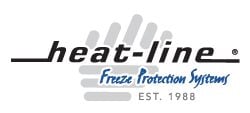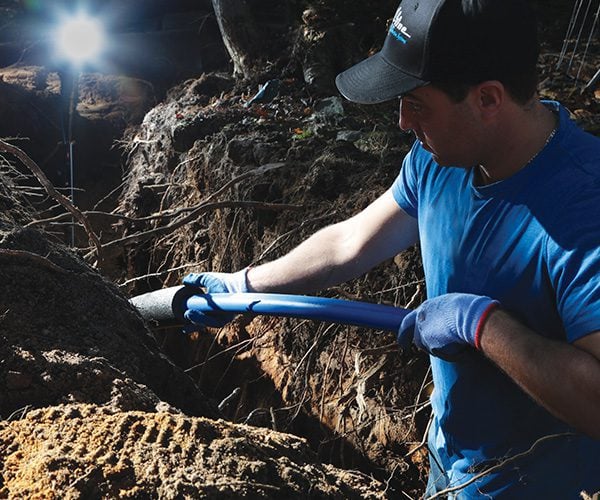All Heat-Line systems are self-regulating, allowing insulation to be added without pipe over-heating concerns. A thermally insulated pipe is not as susceptible to freezing and temperature change. The insulation adds better thermal consistency and efficiency throughout the pipe length.
When a thermostat is located on the pipe under the insulation the system can duty cycle and come on as required. The insulated pipe in combination with the thermostat causes the system to come on periodically for short periods of time saving you up to as much as 80% in energy. When properly insulated the heating cable will remain off for extended periods of time because the amount and degree of heat loss are greatly reduced.
For insulation to work effectively it is important to select the appropriate insulation for the application. For pipes located outside, a waterproof and UV resistant or protected insulation is required. When using insulation sleeves, tape the ends of the insulation together to prevent air or moisture gaps. Big-O drain, PVC, or ABS pipe can be installed over the insulation for above ground applications for mechanical protection. Added mechanical protection is especially beneficial over the insulation at the shore-line when entering a lake and or river to prevent damage from abrasion of sand, gravel, rocks, and or ice. Note: Big-O, PVC, and or ABS pipe alone does not constitute as insulation.
Fiberglass insulation is generally not recommended unless it will be kept in a dry location and an appropriate weatherproof covering is applied and sealed. Within indoor and or dry locations fiberglass insulation can be highly effective.
Spray foam should be avoided as it can seep between the heating cable and the pipe blocking the transfer of heat from the heating cable to the pipe. Apart from this spray foam insulation creates an almost permanent barrier around the pipe and heating cable and as such renders the system technically non-serviceable. If spray foam insulation is to be employed with external heating cable installations apply aluminum foil tape over the heating cable and ensure the tape edges are completely sealed to prevent the creeping of the foam under the tape and heating cable.
If you feel you have a special or unique application for insulation please contact Heat-Line directly and speak with one of our knowledgeable product specialists.
Benefits
- Increases energy efficiency of heating cable by reducing heat loss
- Ensures cold weather reliability
- Helps to ensure consistent contact between the pipe and heating cable
- Easily and quickly installed
- Closed-cell structure does not wick moisture and prevents absorption of condensate
- Resistant to mold growth
- Very low thermal conductivity and water vapor transmission rate
- Cost-effective
- Acceptable for residential, commercial and industrial applications
The benefits of pipe insulation with a Heat-Line system can often be over-looked. While control devices such as thermostats and timers can reduce your operating costs, insulation is a major component required to make your system as energy efficient as possible. A question you must consider is, Would you install the best furnace offered in your home and then not insulate the walls? The answer would be no, and if you didn’t insulate the walls you couldn’t expect the furnace to run as efficiently or reliably as expected.
Pipe insulation should be considered in every application; however, it is not suitable for all installations. Here are 3 simple questions to ask to see if you can benefit from insulation:
1. Is this a new pipe application?
If you are installing a new water pipe, whether it is a Heat-Line or CARAPACE system or pipe bought locally it is easy to insulate the pipe now. Even if you are able to bury the pipe, now is the perfect opportunity to insulate.
2. Is the pipe above ground?
If you can see the pipe at any point it MUST be insulated. Wind-chill and extreme cold ambient temperatures are the main factors that lead to heat loss, causing your pipe to freeze even when protected by heat trace. If the pipe is exposed because of rock, insulate it. If the pipe is exposed where it exists the building, insulate it. Being in a boxed enclosure or big-o drain pipe is not enough protection, it must be insulated. If the pipe is buried, there is no need to dig it up to insulate.
3. Do you have access to the pipe?
If you have access to the pipe then insulation should be considered. Even if small pipes within a sheltered building are exposed there is always an advantage to insulating.
Q – What does Heat-Line recommend for insulation?
A – Heat-Line recommends to use insulation that is best suited to the environment in which it is going to be installed. A common type of insulation employed with Heat-Line systems is fire resistant waterproof polyethylene pipe foam insulation sleeves.
Q – Is insulation required?
A – Insulation is only required when the pipe is exposed to outdoor ambient air temperature (above the ground). For existing applications where the pipe is already buried there is no need to expose the pipe to apply insulation. However, in new pipe installations, it is recommended to insulate the pipe prior to burying it.
Q – Do I have to purchase insulation from Heat-Line?
A – Insulation does not need to be purchased from Heat-Line. When purchasing insulation elsewhere it is recommended to use insulation equal to or greater than the insulation factor provided by a ½ in. wall thickness closed cell polyethylene foam sleeve.
Q- Does outdoor insulation have to be mechanical protected?
A-While most outdoor insulation, such as closed cell polyethylene foam sleeves, is approved for direct moisture contact it is wise to provide some form of protection against mechanical damage and UV exposure from the sun. A common practice is to sleeve the insulated pipe within a larger ‘Big-O’ pipe and or other PVC or ABS pipe.












Reviews
There are no reviews yet.